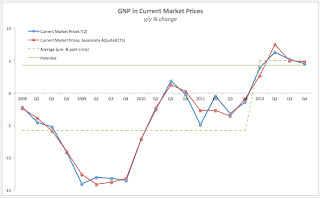having just written about the Irish Services PMI performance in August, here's an update on the link between PMI and actual Services Activity Index, published by the CSO (one month lag).
The latest data from CSO on Services Index will be analysed in the subsequent post, but for now a health warning reminder: Services PMI has barely any bearing on the actual Services activities in Irish economy:
Basically, correlation - from January 2009 through July 2013 - between the Services PMI and CSO Services Activity Index is exceptionally poor: it stands at just 0.1367. Services PMI readings have no explanatory power when it comes to tracking performance of the Services Activity Index. On log-changes chart, PMI is capable of capturing just 0.0071% of variation in Services Activity Index. On straight levels even less. Lags are not yielding any meaningful improvements in explanatory power, neither do non-linear models.
In my view, this testifies to the extreme skews in PMI survey data to reflect the role of MNCs in ICT and IFSC sectors here.
The latest data from CSO on Services Index will be analysed in the subsequent post, but for now a health warning reminder: Services PMI has barely any bearing on the actual Services activities in Irish economy:
Basically, correlation - from January 2009 through July 2013 - between the Services PMI and CSO Services Activity Index is exceptionally poor: it stands at just 0.1367. Services PMI readings have no explanatory power when it comes to tracking performance of the Services Activity Index. On log-changes chart, PMI is capable of capturing just 0.0071% of variation in Services Activity Index. On straight levels even less. Lags are not yielding any meaningful improvements in explanatory power, neither do non-linear models.
In my view, this testifies to the extreme skews in PMI survey data to reflect the role of MNCs in ICT and IFSC sectors here.


















































